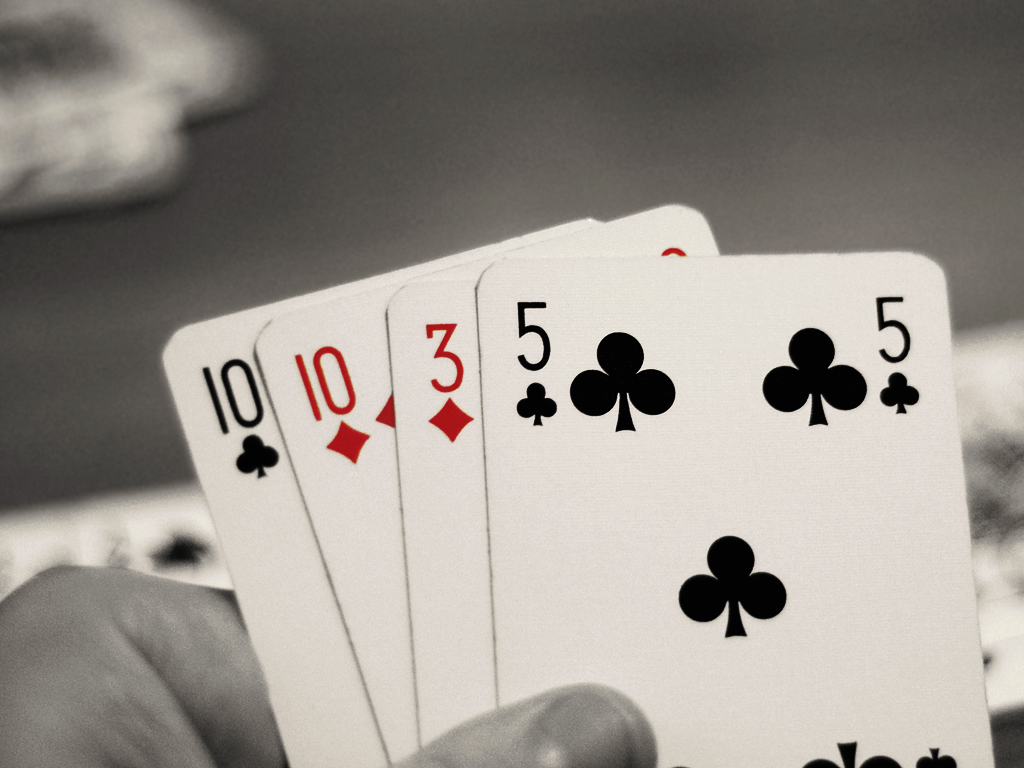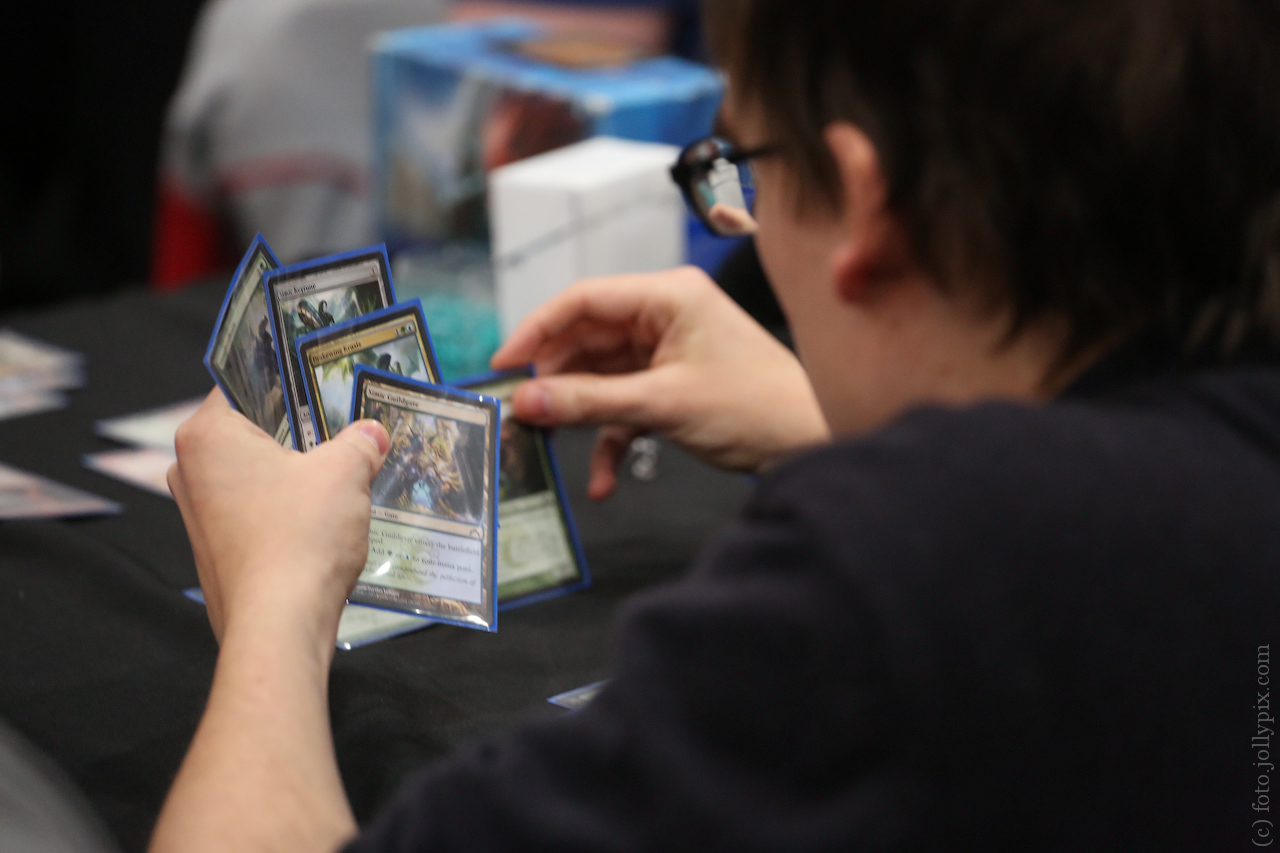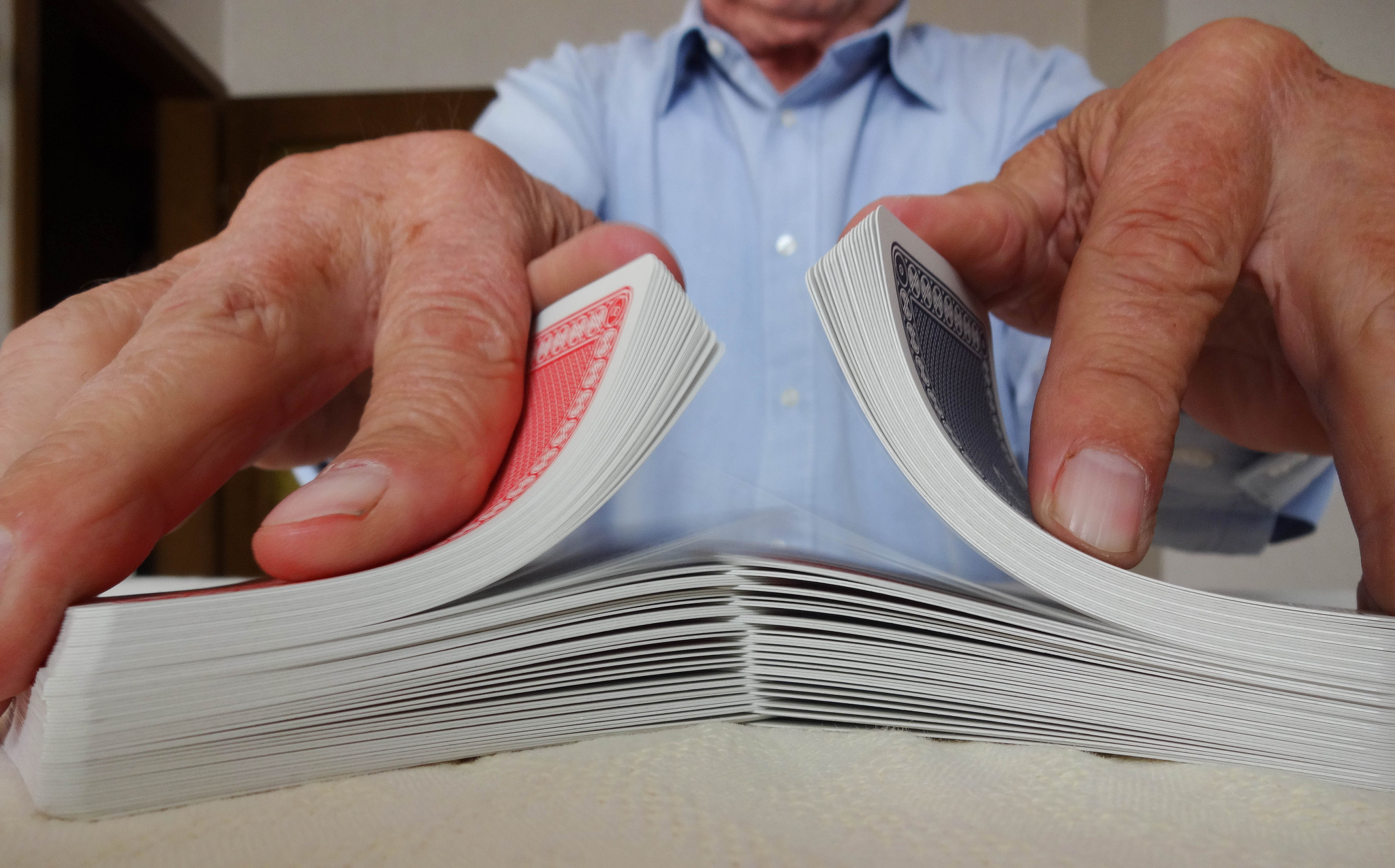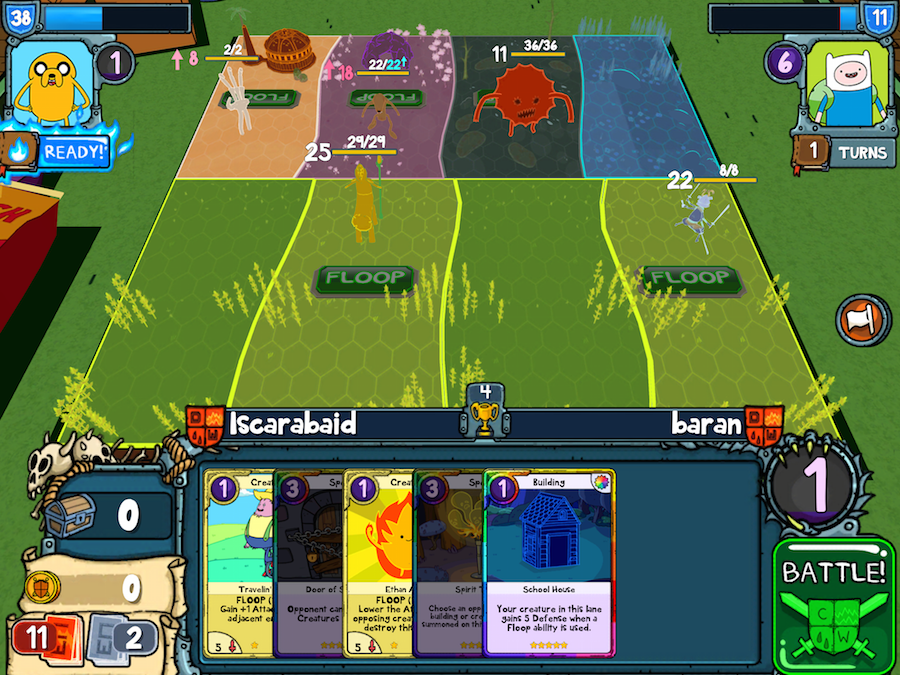Editor’s Note: Nathan Altice’s work here marks an important step in theorizing a Platform Studies that locates commonalities in materiality between analog and digital games. Although he notes that he is a notorious bridge burner in his biography, we think that he has erected an important bridge here, and are happy to publish it even if it is a little longer than our usual fare. Lets join Nathan now, as he deals Game Studies a new hand of cards… -Aaron Trammell
—
Any thin, stiff piece of material can be used as a playing card.
–Detlef Hoffman, The Playing Card: An Illustrated History1
At its simplest, a card is just that: a physical card, which may or may not have undergone any modifications. Its role in the game is both as itself and as whatever information it carries, which can be changed, erased or amended.
–‘1000 Blank White Cards: Structure of a card,’ Wikipedia
In 1993, Richard Garfield revolutionized playing cards. In Magic: the Gathering (Magic), players took the role of dueling spellcasters called Planeswalkers. They battled using constructed decks of cards, or libraries, divided into two basic types: land and spells. A player’s land provided the game’s primary resource, mana, which could then be spent to cast spells—the creatures, artifacts, and other sorceries that populated each player’s battlefield. As in thousands of card games spanning many centuries and cultures, Magic cards came into play in their upright, or portrait, orientation. But once in play, cards could be tapped—rotated ninety degrees—to indicate their use. Tapped lands generated mana; tapped creatures were committed to battle. The simple visual cue gave both players a quick survey of the game’s current resource allotment.
Garfield’s revolution has since become one of card games’ most influential mechanics. In the deluge of collectible card game (CCG) competitors and clones that followed Magic’s debut, tapping has appeared—though never by its patented name2—in numerous themes and variations. The conspiracy-focused On the Edge (1994) uses ‘cranking’ to indicate a card’s triggered power, attack, or movement. Pokémon (1996) extends Magic’s positional cues, using each cardinal direction to indicate a card’s status: a counterclockwise turn shows that your Pokémon is asleep, a clockwise turn shows that it is paralyzed, and a full 180° turn shows that it is confused. Yu-Gi-Oh! (1999) uses rotation to indicate battle position: upright cards attack, rotated cards defend. Whether cards exhaust (Warhammer 40,000: Conquest), boot (Doomtown), engage (Dune), disengage (Galactic Empires), bow (Legend of the Five Rings), floop (Adventure Time Card Wars), open (Heresy: Kingdom Come), tack (Seventh Sea), or turn (Shadowrun, Shadowfist, Firestorm), the physical action is the same.
As a game mechanic, tapping worked because it multiplied a card’s base combinatorial possibilities without the need for supplementary art, text, or other physical alterations. To borrow a computational term, playing cards had a processor upgrade from one bit—face up or face down—to two, and that additional bit widened the spectrum of design possibilities. But tapping also worked because, materially, a playing card is a flat rectangular plane. Squares, circles, hexagons, and other symmetrical geometric surfaces do not lend themselves as easily to rotation. For Garfield, design followed physical form.
Ian Bogost and Nick Montfort inaugurated platform studies in 2009 to research the oft-ignored material substrate of digital media—graphics processors, cartridge ROM, disk sectors—and analyze how its specific form shapes the look, sound, and feel of the software it supports.3 Atari VCS and Nintendo Entertainment System games, for instance, do not differ merely due to programmer fiat or raw processing speeds—the material hearts of these machines create specific affordances that shape design from the bottom up, circuit to code.
While prescribed for computational platforms like videogame consoles and personal computers, platform studies is pliant enough to accommodate non-digital media as well. Though they lack bit shift registers or operating systems, cards are platforms too. Their ‘hardware’ supports particular styles, systems, and subjects of play while stymying others. Of course, pasting computational metaphors atop media that pre-date the analog/digital divide by more than a millennia risks imposing anachronistic technological norms that never factored into their design or use. But at a time when card games are experiencing a popular resurgence—especially in digital form—it is worthwhile to consider both how analog and digital characteristics overlap and intercede and what types of play that cards encourage or discourage. Magic’s simple rotational gesture exploded the playing card design space, prompting designers to reconsider how cards, as a material form, could be used for games beyond the standard suited deck.4 Playing cards’ shift to digital platforms similarly raises new design questions.
There are at least five interleaved platform characteristics that structure card game design. Cards are planar, uniform, ordinal, spatial, and textural. These five characteristics appear consistently in the centuries-long history of card games and define the playing card platform’s formal contours. However, these are not exclusive but exceptional qualities. Videogames are certainly good at counting and sorting numeric data, but a card’s material form encourages ordinality in ways that other game media, whether badminton, backgammon, or Bioshock, do not.
Planar
The history of cards is a history of rectangles. Though scholars disagree about playing cards’ exact date or location of origin,5 one design pattern is consistent across disparate cultures and centuries: flat, rectilinear forms. Historical exceptions exist, most notably the circular Ganjifa cards prominent in India,6 but the rectangle, taller than it is wide and almost universally held in its upright position, dominates the platform. Why this shape took precedence is unclear. Some historians believe cards trace their lineage to a marriage of Korean and Chinese divinatory arrows, narrow bamboo lots, and paper money.7 resembled books in miniature, a shape that fit comfortably (and readably) in the hand.

As planar surfaces, cards have two opposing sides that, barring any imaginative folding or mirror tricks, can not be viewed simultaneously. In most games, the card’s back—decorated with a uniform pattern to make all cards appear identical—faces one’s opponent(s) while the front displays information meant to be hidden from other players. This simple binary state has spawned countless game variants that rely on concealment. Poker is the obvious example since its primary mechanic is secrecy, and it is distinctive as a game that can be won without winning, since bluffing successfully can coerce an opponent to concede a superior hand. Compare this to board games like chess, go, checkers, Monopoly, or Risk, where the distribution of information is equal across all players. Winning in such games defers to skill, chance, player stamina, alliances, or other means—but not concealment. Chess players cannot hide their king until a decisive checkmate, but card players can stow an ‘ace in the hole.’ In cases where board games need to incorporate concealment (or corollaries like randomization), as in Monopoly’s Community Chest or Risk’s missions rules, cards provide the material means.
The card’s planar surface also excels as a support for text, color, pattern, icons, and many other forms of art and design. In every playing card throughout history, whether used in games, education, or divination, the planar surface is a canvas in miniature, though the density and style of design varies tremendously across games. In past centuries, when card games were considered frivolous, unlawful, or sinful, card designers crowded card faces with moral, religious, or historical lessons, leaving the portion of the card reserved for game-specific information proportionately miniscule. During the mid-90s heydey of CCGs, rule text, game iconography, and statistical cruft dominated the card’s surface, sidelining decoration in favor of game-specific information.
Often subversions of platform characteristics, like reversing a card’s concealment, yield the most interesting design results. In Hanabi (2010), for example, players hold their cards face out and must use their teammates’ verbal clues to deduce their own hand (and help others do the same). Slapjack, a children’s game, uses a similar mechanic. Each player controls a stack of face-down cards. All players reveal one card per by flipping their card into a common pile so that their opponents can see it first. If a jack is revealed, the first player to slap their hand atop the card wins the pile. One Night Ultimate Werewolf (2014), a variation of the Russian game Mafia (1986), combines secrecy and role-playing to distribute information unevenly across the player group. No single player knows which players claim which cards and thus must deduce their roles (e.g. human or werewolf) through logic, conversation, and intrigue. These games undermine centuries of playing card convention by forcing players to reveal their cards to their opponent(s) first, though at drastically different tempos.
Playing cards’ planar surfaces simultaneously excel at both displaying and concealing information, whether from one’s opponent, as in most gambling games like like บาคาร่า คือ, or from oneself, as in games of Memory or patience (i.e., solitaire). Concealment in turn configures the arrangement and distribution of participating bodies. Card players commonly face one another in a shared space, allowing them to read both their cards and one another. Compare this to digital games, which arrange bodies (or typically, a single body) facing a screen, forcing cooperation or competition to either take place in that shared visual space, making secrecy and face-to-face play more difficult, or across multiple screens, often networked at a distance. Networked screens, whether ad hoc or online, reinstate concealment, but often at the expense of a shared local play space. Card design, both materially and mechanically, assumes local play and often reinforces this trait through common cards (e.g., the river in Texas Hold’em). Any dislocation of space (e.g., a Skype game) or time (e.g., play-by-mail) elevates concealment from rule to threat and often requires the intercession of an impartial—and frequently digital—mediator to ensure fairness.
Uniform
Playing cards, no matter their geometric form, are cut to identical sizes. Variations exist across games—tarot, bridge, and poker formats, for instance, are standards with slight rectilinear differences—but within games, cards typically share the same profile. Uniformity, in turn, breeds the deck, or multiple cards stacked atop one another, and the shuffle, the process of reordering a deck’s sequence at random. In concert, the deck and shuffle introduce chance and mathematical variation. Platforms like แอพคาสิโนยูฟ่า, offers players the opportunity to enjoy these traditional games in a digital format.
When chance comes into play, uniformity guarantees fairness. In sport, standardization is crucial to competition. The Official Rules of the National Basketball Association, for example, dictate that the backboard must be a 6’ x 3.5’ transparent rectangle, the hoop measure 18” in diameter, and the basketball maintain an air pressure of 7.5–8.5 lbs. Creating regional backboard and hoop variations would make it impossible to compare one player’s or team’s skill to another. Similarly, in the world of gambling, prior knowledge of a deck’s sequence would tilt a card player’s advantage unfairly, a fact that motivates the casino industry’s sophisticated surveillance and security systems.

Historically, card backs were uniform in their blankness. They had no patterns besides those inherent to their supporting surface, typically thick paper or cardboard. However, the natural wear and tear from handling became an unfair competitive tell, so card makers devised uniform printed patterns to mitigate cheating. Uniform card faces took longer to adopt. Prior to the seventeenth century, court cards were single-ended, meaning that the king’s portrait, for instance, only had one proper orientation. Strategic players discovered that they could spot a court card’s presence when their opponent manually sorted their hand. Double-ended court cards obviated that need. Likewise, standardized, uniform corner indices notating the card’s suit and value were adopted in America around 1870 to allow players to hold their poker hand in tightly-gripped ‘fans.’8
Uniformity speaks primarily to the cultural and economic affordances of card games. The history of playing cards is hewn so closely to the history of mechanical reproduction—from Chinese woodblock printing to German wood- and copper-engraving—that uniformity is now a marker of industrialization and capitalist exchange.9 Mass production ensures that card replication is cheap and reliable, so one player’s cards will be no better or worse than any other’s. Cheap reproduction in turn drives the playing, trading, and collectible card industries, where scarcity and demand can transform a few cents of cardboard (or for digital games, a few kilobytes of data) into a valuable commodity. Today, the uniform surface becomes a site for branding and advertising. The Yu-Gi-Oh! card back, for instance, announces its participation in an international culture of commodity, exchange, reproduction, and play.
Ordinal
Since cards are planar and uniform, they can be grouped into sets, counted, sorted, ranked, indexed, and ordered. The standard playing card, dating at least from the fourteenth century, uses the card surface to count and group with numerals (typically one through nine) and suits (commonly four), respectively. Though the sequence, count, and distribution of numbers and symbols vary throughout history, most card games from the fourteenth through twentieth centuries rely on ordinality as their base mechanic, using a card’s printed value or symbol to form a series or group of related cards.
Rummy, a card game from the early twentieth century, is the classic American example of platform ordinality. In two-hand rummy, each player is dealt ten cards from a standard pack of fifty-two. The object of the game is to form sets, which may be one of two types: a group of three or four cards of the same rank (e.g., four 5’s) or a sequence of three or more cards with matching suits (e.g., ♣KQJ). Players meld, or lay down, their sets until they are able to deplete their entire hand. A secondary ordinality comes into play during scoring, as face and ace cards are assigned numeric values.

More modern ordinal games are notable for their redesigns of the classic playing card deck. Uno (1971) trades royal suits and symbols for a restrained color spectrum (yellow, blue, red, green), a more limited numeric run (0–9), and custom cards that control sequence or card draw (e.g., ‘Skip’ and ‘Draw Two’). Phase 10 (1982) adopts Uno’s colors, but being a modern rummy variant, uses the standard playing card sequence (1–12) along with ‘Skip’ and ‘Wild’ cards. Skip-Bo (1967) is simpler still, using non-suited numerals and a ‘Skip-Bo’ wild card to construct card sequences from one to twelve.
Ordinality exploded after Magic: The Gathering, as card games adopted a statistical complexity previously reserved for videogames and pen-and-paper roleplaying games. Multiple interacting variables and supplemental rule text replaced simple suits and ranks. Magic, for instance, uses a collection of custom cards, replete with an ideographic iconography, to multiply the number of in-game combinatorial possibilities. Like Uno and Phase 10, Magic replaces suits with colors, each representing a mana type—white, blue, black, red, or green—whose cost must be paid to bring a card into play. For creature cards, royal ranks are replaced with power and toughness, designating how much damage a card can deal and endure, respectively. Card-specific rules printed directly on the card face introduce further variations. Today, Magic’s complexity compounds further due to the near-infinite range of card combinations made possible from its extensive library of cards, now thousands deep. Even in a standard fifty-two-card playing card deck, there are roughly 8.0658 x 1067 possible deck combinations—greater than the number of stars in the observable universe.10 Magic’s deck variations outnumber the celestial heavens of trillions of metaverses.
Magic more cleverly adopts (and patents) ordinality, via set creation and collection, as a correlative metagame. Players construct individual decks from a common card pool, then test them in competition. But the card pool is governed both by official sanctions (cards are regularly retired or banned from official play) and a purposefully constrained supply chain. By design, Magic borrows the collectible quality of sports and pop culture trading cards, using scarcity and concealment (via randomized ‘booster packs’) to make collection a game unto itself.

Prior to CCGs, players could purchase customized playing card decks, but the customization was limited to the cards’ decorative features. Your deck and mine might look wildly different, but we were guaranteed that both contained the same fifty-two cards. Selling cards in randomized packs and artificially limiting the mass production of particular cards introduced economic ordinality to the card platform and created an uneven distribution of mechanical possibilities within games. Participating competitively in CCGs meant an ongoing investment in new cards. Rarer cards became collectibles, sought after not only for their usefulness in play but for their value within the trading card economy. Card manufacturers and designers reinforced players’ consumptive impulses by incrementally retiring older cards and increasing the capabilities of newer cards—a process known as ‘power creep’—and ensured a perpetual stream of revenue from a single game.
In playing cards, ordinality embodies a hierarchical distribution of cultural capital, a reflection of social stratification represented for centuries through playing cards’ royal visages. Kings outrank queens who outrank jacks and so on down the line of succession. For today’s players living in republican or democratic societies, royal cards are anachronistic reminders of a monarchical past, more caricatures than relevant cultural symbols. But the ordinal surface can still be a canvas for political hegemony. Following their 2003 invasion of Iraq, the U.S. military distributed decks of camouflage-backed ‘personality identification playing cards’ to active troops (and online). Starting with Saddam Hussein as the ace of spades, members of the Baath Party and the Revolutionary Command Council were ranked and ordered according to their ‘most wanted’ status. The familiar playing cards, equally useful during downtime, gave soldiers a pictorial, ordinal shorthand for their most valuable targets, layering a proxy card game atop their war games. And while the U.S. military portrayed their adversaries as unwitting components of an international contest, the stakes were serious—many of those featured on the cards were subsequently captured or executed.11

Spatial
Cards occupy space. Excluding some portable games or compact ‘microgames’ (e.g. Love Letter (2012) uses only sixteen cards), cards require a flat surface for arrangement and display, setting an upper bound for a game’s spatial density and distribution. A game using ten thousand unique cards is not impossible to design (though it might be costly to manufacture), but it strains the limits of player comprehensibility and practical tabletop space.
Abstract card games that rely solely on concealment and ordinality use tabletop space for card display, sorting, or boundary markers. In blackjack, space simply sequesters player and dealer cards. No specific card arrangement is necessary beyond keeping each players’ cards separated and in view. In Memory, cards are commonly arranged in rows to provide players’ additional positional cues for re-locating cards. Such spaces have no in-game meaning, symbology, or representational content. Space is simply the neutral site for play.
However, card arrangements can describe metaphorical, narrative, representational, geographic, and other hybrid spaces. Metaphorical spaces abound in thematic games, especially fantasy and science fiction, where fictional lore provides mechanical motivation for card placement. Spellfire (1994) uses a card arrangement called the formation, a six-card pyramid of realm cards whose base faces the cards’ owner. Thematically, these realms (which may represent single nations or entire empires) are kept distinct from other diegetic spaces (e.g., Limbo, Abyss, and Void) and non-diegetic spaces (e.g., one’s hand or discard pile). The formation and its accompanying spaces do not depend on precise positions (e.g., a player’s discard pile might be to the left or right of the formation), but their interior arrangements are mechanically literal, since realm cards at the top of the formation shield those further down and cards in the Void are no longer in play.

In Very Clever Pipe Game (1997), cards in play become the game space. Each card depicts a section of pipes and connectors at various angles that players use to complete pipe circuits. The scoring player then removes those cards from the game and fills the gaps with new cards. Similarly, in FlowerFall (2012), players drop flower cards in order to construct a connected garden patch on the table below.12 The storytelling game Once Upon a Time (1993), in contrast, uses cards to construct player-mediated narrative space. Cards list story prompts that a player uses to build a collaborative fairy tale. Boss Monster (2013), inspired by the maps of platformer videogames, combines both approaches: players lay down room cards in sequential order, creating a linear space that players must traverse from left to right and a narrative space that tells the ‘story’ of a hero’s quest.
All games engage space, but how they do so depends on their material form.13 Board games, like many sports, clearly demarcate a play space set apart from their surroundings, provide a literal platform for other play implements, make quantifiable spatial comparisons straightforward, and provide a large canvas for illustration and text. So both sports and board games excel at games of territorial capture and control, spatial mastery, mapping, and traversal. Football and Candyland players alike struggle to move from start to goal line. Cards, in contrast, create and contain space that is more mobile, modular, and metaphorical. Card space is space you can touch.
Textural
Cards are made for hands, and a linguistic convention arose to reinforce the link: a hand designates the cards currently in a player’s possession. And touch is a ubiquitous partner of card game design. Shuffling, stacking, dealing, cutting, fanning, folding, flipping—all are manual processes that require players to touch their cards. Observe any high-level competitive card game player, from poker to Magic, and you will notice the near-obsessive compulsive degree with which they manipulate their hands.

The card’s planar surface promotes easily handling. Cards are small and thin enough to hold in multiples, sort quickly, rearrange, and manipulate individually, yet durable enough to withstand hundreds or thousands of plays. Manufacturing improvements have likewise refined the card’s texture over centuries. Rounded corners decreased wear-and-tear (and cheating), for example, and the ‘pneumatic finish,’ invented by William Thomas Shaw in the mid-twentieth century, permitted ‘one card to slide easily over another and the pack to be easily shuffled and dealt.’14
Texture also regulates duration. Computers handle digital cards at microprocessor speed. Ultimately the cards on screen are a visual abstraction of numeric variables stored in memory. Analog cards require external physical computation because their ordinal values are hewn to their surface. And physical computation takes time. Players set up their decks, sort their hands, consider their plays, rifle their cards, and watch their fellow players. Texture throttles the pace of analog play.
Without the proper texture, the card platform would be less suitable for ordinal play. Modern checkers are stackable, but their thickness—a boon to their use as movable playing pieces—precludes any practical use for building decks, sorting, or counting. A baseball’s shape and texture are ideal for handling, especially the subtle grip articulations pitchers adopt to control the ball’s flight, but spheres are useless for stacking or concealment. Thin wooden planes make for ideal paddles in table tennis, but their rigid surface would both wreak havoc on hands and make shuffling impossible. Conversely, playing cards are poor substitutes for checkers, baseballs, and ping-pong paddles. Each platform for play demands a suitable texture.15

Texture again reinforces cards’ local character. Touching implies proximity and proximity demands a shared space. Divorcing cards from texture requires a fundamental reconfiguration of their material form, a shift experienced most acutely in their translation to digital objects.
Card Wars
Though in their early years videogames largely modeled their analog kin, especially sports (e.g., tennis) and playing cards, computers have significantly replaced or eroded many of the latter’s platform characteristics. Playing cards’ simple ordinal sets were straightforward to model both mathematically and graphically, and the raster monitor’s gridded field proved an ideal replacement for both rectilineal representations of cards and their playing spaces. Concealment and competition, however, proved more elusive, even mutually exclusive. Microprocessors were not powerful enough to handle the complex artificial intelligence necessary to simulate a human opponent, but human opponents sitting side-by-side in front of the same screen would be privy to one another’s cards.
Time and technology has erased these limitations: monitor resolutions support photorealistic cards; artificial intelligence offers all levels of competitive play; and online or ad hoc networks give each player their own screen. But texture still remains a significant technological hurdle. The ripple shuffle is replaced with the dry random number generator, a poor substitute for a dealer’s trained hands, no matter how efficient the computer shuffle may be. Digital skeuomorphs of physical surfaces remain stopgap solutions. HOYLE Video Poker traffics in faux-wood grain and felt, its ‘video’ cards perfect simulacra of their physical predecessors, but a fat, shaded ‘DEAL’ button replaces the textures of flesh on polymer. Apple’s popularization of touchscreen devices returns cards to fingers, but at the cost of a new kind of uniformity: every object we touch is but a thin veneer of glass atop illuminated pixels.
Again, none of the playing card platform’s qualities are unique, or even exceptional. Computers are the clear ordinal powerhouses—even the earliest room-sized machines of the 1940s could calculate hundreds or thousands of times faster than the most skilled human computers. Today’s processors best us by the trillions. The key distinction is that cards are ordinal in form and computers are ordinal in process. Not to discount the logic gates that ultimately drive binary calculation, but such microscopic mechanisms are abstracted away through multiple layers of electrical and software engineering, while cards’ ordinal form is always locally manipulable. Sorting, shuffling, and grouping are manual processes and thus face a hard physical limit on calculation unless players use supplementary tools, whether dice, calculators, or laptops. Computers excel at calculating complex maths, storing variables, iterating through loops, and branching based on user input—all processes that simple material ordinality cannot adequately support. Consequently, genres that rely on such processes, like role-playing games, make for poor card games. And when card games are translated to digital form, they often pick up a platform-specific layer of statistical complexity, as in Hearthstone’s RPG-like character leveling.

There are tens of thousands of digital card games on every imaginable computer platform, and most players probably don’t mind sacrificing their physical cards for infinitely thin planar surfaces, pixel-perfect uniformity, and processor-driven ordinality. But the best of these games recognize the loss and replace playing cards’ materiality with virtual supplements beyond simple skeuomorphs. Adventure Time Card Wars (Kung Fu Factory, 2014; Cryptozoic, 2014) is one of the most compelling examples not only because it exists both as a physical and digital card game, but also because each uses different rules and mechanics suited to its respective platform.16
Both versions of Card Wars are two-player competitive CCGs that restrict their play space to four lanes representing a particular landscape (e.g., SandyLands, Useless Swamps). Players may place only one creature and one building per lane, and direct card battle may only take place between competing cards that share a lane. Ordinal comparison of competing cards’ attack and defense statistics, factoring in any additional flooping or building modifiers, determines the battle results.
Beyond these basic elements, both games’ mechanics diverge significantly. In analog Card Wars, ordinal computation is appropriately minimal. Card statistics and modifiers are easy to add, subtract, and compare, and cardboard counters track any persistent creature damage. Digital Card Wars smartly hands computation over to the computer. Card statistics are wildly inflated from their analog twins—the Struzann Jinn card’s 1 ATK/11 DEF, for instance, balloons to 15/25. Likewise, both games’ resource tempos vary. Analog Card Wars allows two actions per turn, and card costs are balanced accordingly; digital Card Wars uses an escalating resource pool that starts at 2 and increments to 10, throttling the play of higher-cost cards. The physical action of flooping, or rotating, cards becomes a tappable button on the tablet screen, and the straightforward numeric comparisons between battling cards has a digital-exclusive augment: for each card battle, a carnival-style roulette wheel appears. Tapping the wheel at a specific point causes double damage—or a miss.
Digital Card Wars recognizes the peculiarities of the tablet platform and prunes unnecessary physical ornament from its presentation. Once cards are played to their landscapes, they evaporate, their constituent creatures and buildings rising from the playing field as animated 3D models. Like many of its digital peers, Card Wars is easily conceivable as a game using figurines, tokens, or even spreadsheets, since none of the playing card’s platform-specific characteristics are essential for play. Ordinality is easily handled by a microprocessor; neither planar nor spatial qualities are constrained by physical limitations; uniformity is not necessary for concealment, since players play on individual computers; and texture is secondary ornamentation. Players may flick their cards onto the playing field, but once there, the physical referent vanishes.
Card Wars, Hearthstone, and many other digital-native card games reference physical cards for their commodity status rather than their material and mechanical restraints. Analog cards involve inks, cardboards, polymers, printing presses, laser cutters, foil wrappers, transport vehicles, shelves, and game stores. Even absent the artificial supply constraints of the CCG market, analog cards face real physical constraints, whether they be dwindling retail spaces or damp basements. While digital cards involve significant labor—programming, graphic design, distribution, advertising—their supply is theoretically limitless. Yet digital card games regularly constrain card distribution, manufacture ‘rare’ cards, and create local economies that translate time or legal tender into virtual coins, gems, chests, and boosters.
Formalizing a platform’s characteristics is more than a descriptive exercise, especially when we track a game’s adaptation—or port, in computer game parlance—across multiple divergent platforms. Identifying which platform fixtures a designer chooses to drop or adopt in that process tells us a lot about their conceptual priorities, their economic concerns, and their participation in (or ignorance of) cultures of play. Cryptozoic’s Card Wars is sold in $19.95 starter boxes, supplemented by $2.99 booster packs that draw from a small card pool, and distributed by online and brick-and-mortar retailers, including Target and Amazon. Kung-Fu Factory’s Card Wars is a $3.99 app available through Google’s and Apple’s respective digital storefronts, supplemented by in-app purchases of gems that otherwise require hours of in-game play to mine, and has a card pool that can theoretically multiply infinitely. Shedding the vestments of the playing card platform save for its material supply constraints acknowledges that today’s mobile app economy demands game prices approaching zero, augmented by persistent and perpetual ‘micro-transactions.’ We must acknowledge that physical playing cards are a niche business compared to western culture’s absorption in mobile digital play, and that a digital playing card is still a playing card, but not a platform.
–
Featured Image “contestant #2,” by Kaitlin M CC BY-NC-ND.
–
Nathan Altice is an instructor of sound and game design at Virginia Commonwealth University and author of the platform study of the NES/Famicom, I AM ERROR (MIT, 2015). He writes at metopal.com and burns bridges @circuitlions.



One thought on “The Playing Card Platform”
Comments are closed.